|
Since
its introduction in 1966, the Ruger Number 1 single shot rifle
has appealed to a certain type of shooter. Introducing a single
shot at a time when bolt actions and autoloaders were all the
rage was baffling to many in the gun industry, but Bill Ruger
once again proved that bucking the trend was an ingenious idea.
Today, there are several single shot rifles on the market, but
the Number 1 is still one of the best choices available, and is
one of the strongest single shot sporting rifles ever built.
Seldom
does a new shooter choose a single shot rifle, unless he is
looking for a very inexpensive center fire deer rifle, such as
one of the break-open singles on the market. While the
break-open guns are a good, inexpensive alternative to repeating
rifles, the Ruger Number 1 is a different type of rifle, for a
different type of hunter. Most who buy a Number 1 already have a
good bolt action or two in the gun rack. In fact, there are many
good bolt action rifles available for less money than a Number
1. The hunter who chooses a Number 1 usually does so for other
than economic reasons. The hunter who carries a Number 1
afield is akin to the archer who uses a longbow or the
muzzleloading hunter who uses a flintlock. He is confident in
his rifle, his ammo, and his ability. While the Number 1 is a
modern, strong, reliable single shot rifle, it hearkens back to
the days of the great British and Continental single shots used
in Africa, and to the American single shots used in the western
territories of the United States over one hundred years ago.
Hunting
with a single shot is a different feeling than that of hunting
with a magazine rifle. While they can be reloaded quicker than
most would imagine, it is usually a very confident hunter who
will place his success, and sometimes his personal safety, upon
one well-placed shot. Over the years, I have owned and hunted
with a few Number ones, and have found each to be a very capable
rifle.
The
classic lines of the Ruger Number 1 show the influence of
earlier designs, but it is arguably the best single shot design
to date. The falling block action contains a hidden hammer with
a perfectly placed top tang safety. The under lever is separate
from the trigger guard, and the trigger is of a simple design
that is conducive to accurate shooting, and can be easily
adjusted for weight of pull. The ejector can be converted to
extraction-only if one so chooses, but handily throws the
empties clear of the rifle as shipped from the factory. On the
blued steel guns, Ruger uses attractive checkered walnut for the
two-piece stock. The last time that I counted, the Number 1 was
offered in over twenty-five different chamberings, from the
petite .22 Hornet up to the mighty .458 Lott. The Number 1 is
offered in several different configurations of stock design and
barrel length, in blued steel or stainless. In all, there are
over fifty different combinations of caliber and variation of
the Number 1 rifle currently offered.
A
couple of months ago, I learned that Ruger was to offer the
Number 1 chambered for the old and formerly obsolete .405
Winchester cartridge. I immediately called and proceeded to beg
for one. It wasnít long before the rifle arrived, and is the
subject of this evaluation.
The
.405 Winchester was first introduced in June of 1904 as the most
powerful American cartridge then available. It was chambered in
the Winchester model 1895 lever-action rifle, and is the
cartridge most associated with that rifle, even though it was
built in relatively small numbers. The majority of 1895 rifles
were built for Russia and chambered for the 7.62x54R cartridge,
but the .405 grew to legendary status helped immensely by the
writings of Theodore Roosevelt. TR took a couple of the .405
rifles to Africa on an extended safari, and harvested many
species of dangerous game with the powerful lever guns. He
referred to the .405 as his "Big Medicine" rifle.
While the .405 has been chambered in a very few other rifles,
the cartridge was allowed to die with the 1895 rifle in the
1930s. Winchester has recently imported a few 1895 rifles
manufactured by Miroku in Japan chambered for the .405, but the
Ruger Number 1 is the first major American made .405 in almost
seventy years.
Ruger
chambers the .405 in their Number 1H Tropical variation, which
uses a heavy twenty-four inch barrel, and thanks to the compact
action, has an overall length of only forty-one and one-half
inches. The Tropical rifle in .405 weighs in at just over eight
pounds, depending upon the density of the wood. The Tropical
also has the handsome Alex Henry forearm design along with a
barrel-band sling swivel mount. It has another barrel band at
the muzzle to which the front sight is mounted, along with a
rear sight mounted to the quarter rib. Scope rings are provided
which also mount to the quarter rib. The overall appearance is
one of classic elegance. The Number 1H is, in my opinion, one of
the best looking production rifles made.
For
accuracy and reliability testing, I turned to Hornady for newly
manufactured ammunition, dies, and cartridges cases. Original
Winchester ammo and brass has been out of production for many
years, and has become both scarce and collectable. The factory
ammo and components now manufactured by Hornady are readily
available and manufactured to their usual high standards.
Hornady has suddenly made the .405 a viable cartridge once
again. I loaded a variety of bullets from Hornady, Barnes, Mt.
Baldy, and Remington. The Hornady was the same 300 grain
soft point jacketed bullet as used in their factory ammunition.
The Barnes bullet used was the only one currently offered by
them, but it is a dandy bullet for the .405. It is their 300
grain all-copper X-bullet. The hard cast gas-checked 300 grain
flat point from Mt. Baldy proved to be an accurate alternative
to jacketed bullets, and should be a very good choice for big
game hunting. For a suitable hunting load for whitetail deer, I
loaded the Remington .41 caliber 210 grain jacketed soft point
pistol bullet, but I have yet to test it on game. Loaded to a
velocity in excess of twenty-five hundred feet per second, it
may prove too fragile for whitetail, but would certainly do well
on smaller game. The accuracy with this bullet was as good as
the rifle bullets. The Ruger proved capable of good hunting
accuracy, placing the bullets with each load tested into
three-shot groups of under one and one-half inches at one
hundred yards. Recoil with the loads listed can best be
described as stout. Firing the factory loads, and even the
heavier handloads, proved comfortable from an offhand position,
but while shooting in excess of eighty rounds in one bench
session, it soon became painful. The Ruger has a rubber butt
pad, but it is of a relatively hard composition. The favored
powder in this gun turned out to be Alliant Reloder 7. It
gave good accuracy and velocity with each bullet tested. In
deference to the old lever actions in the hands of some
shooters, specific load data will not be listed. The loads
tested were perfectly safe in the strong Number 1, but would
most likely be excessive in a one hundred year old rifle. All
velocities were measured at a distance of twelve feet from the
muzzle, at a temperature of sixty-two degrees. The results of my
favorite loads were as follows:
| Bullet |
Powder |
Velocity
FPS |
Accuracy
in Inches |
| Hornady
300 |
Factory
load |
2105 |
1.75 |
| Hornady
300 |
Reloder
7 |
2442 |
1.15 |
| Barnes
300 X |
Reloder
7 |
2454 |
1.45 |
| Mt.
Baldy 300 FP |
Reloder
7 |
2376 |
1.20 |
| Remington
210 JSP |
Reloder
7 |
2558 |
1.375 |
All
loads used new Hornady cases, Winchester WLR primers, and none
were crimped. All loads were chronographed over a PACT
chronograph. Other powders which proved very useful were Hodgdon
322 and Accurate 2015. For heavier bullets, Barnes once produced
325, 350 and 400 grain X-bullets in .411" diameter, and
they are still available if you do some searching, but none were
tested for this article, as they are out of production at this
time. The 300 grain bullets tested should prove useful for
general big game hunting, and the 300 grain Barnes X should be
able to penetrate adequately on any soft-skinned big game
animal, including the large bears. I have not, however, fired
these bullets at any large bear, but am basing this finding on
the stellar reputation for penetration of the Barnes X, and on
my experience of using the X-bullet in other cartridges.
With
the introduction of the Ruger Number 1 in .405 Winchester, along
with the availability of ammo and components, shooters and
hunters now have available a very handy rifle in a grand old
American cartridge. The .405 is about much more than just
nostalgia. It is a powerful big game cartridge that was just too
good to die.
Check out the full line of Ruger products
here.
Hornady
dies, ammo, and components can be found at: www.hornady.com.
The
Barnes X-bullet and Mt. Baldyís excellent cast bullets can be
found on their respective websites at: www.barnesbullets.com
and www.mtbaldybullets.com.
Jeff Quinn
  
Got something to say about this article? Want to agree (or
disagree) with it? Click the following link to go to the GUNBlast Feedback Page.
|
|
Click pictures for a larger version.

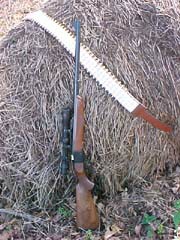
A long-time fan of Ruger's Number 1 rifles, the author
was happy to see it chambered for one of his favorite
cartridges, the .405 Winchester.
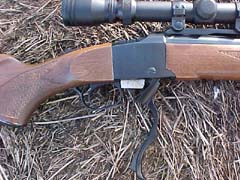
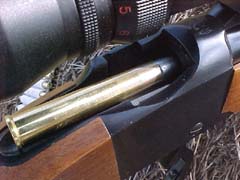
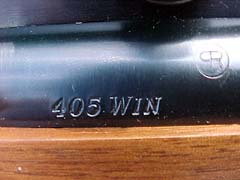
The strong and precise action of the Ruger Number 1
accepts long, fat cartridges such as the .405 Winchester with
ease.
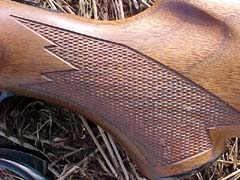
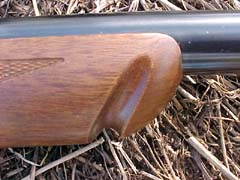

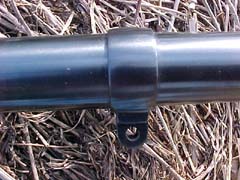

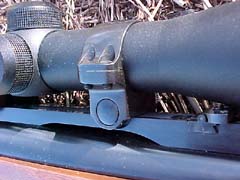
Ruger's Number 1H Tropical rifle features (top to
bottom) a tastefully-checkered stock and Henry forearm, a
rubber butt pad, a barrel band sling swivel stud, and a barrel
band front sight. The quarter rib incorporates a folding rear
sight and Ruger's excellent scope mounting system.
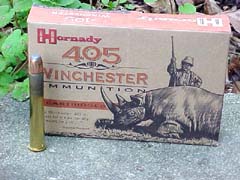

Hornady
has given new life to the .405 Winchester cartridge with their
excellent ammunition, dies, and reloading components.
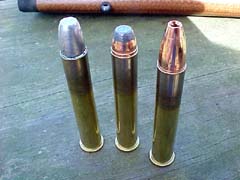
Jeff's favorite
handloads for the .405 Winchester use (left to right): Mt.
Baldy's 300-grain hard-cast gas check bullets, Remington's
210-grain JSP pistol bullets, and Barnes' 300-grain X bullets.
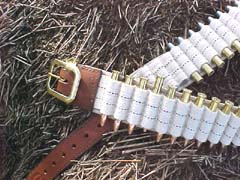
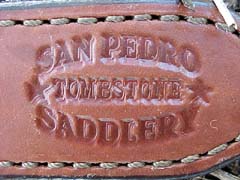
San Pedro Saddlery
makes a great cartridge belt that is both beautiful and
practical for those big ol' cartridges.
|
![]()